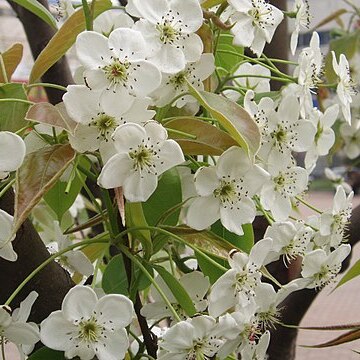Trees to 5–8 m tall. Branchlets purplish brown when old, terete, robust, densely pubescent when young, glabrous when old, sparsely lenticellate; buds dark purple, ovoid, apex obtuse; scales pubescent at margin and apex. Stipules caducous, linear or linear-lanceolate, 1–1.3 cm, membranous, pubescent, margin glandular denticulate, apex acuminate; petiole 2.5–7 cm, densely tomentose when young, soon glabrescent; leaf blade ovate or elliptic-ovate, 5–11 × 3.5–6 cm, both surfaces tomentose when young, soon glabrescent, base broadly cuneate, rarely subrounded, margin spinulose-serrate, apex acuminate, rarely acute. Raceme umbel-like, 7–10-flowered; peduncle tomentose when young, soon glabrescent; bracts caducous, linear, 1–1.5 cm, membranous, adaxially brown tomentose, margin entire, apex acuminate. Pedicel 1.5–3 cm, pubescent when young. Flowers 2–3.5 cm in diam. Hypanthium cupular, slightly pubescent when young. Sepals triangular, 3.5–5 mm, abaxially glabrous, adaxially brown tomentose, margin glandular denticulate, apex acuminate. Petals white, ovate, 1.2–1.4 × 1–1.2 cm, base shortly clawed, apex rounded. Stamens 20, ca. 1/2 as long as petals. Ovary 5-or 4-loculed, with 2 ovules per locule; styles 5 or 4, ca. as long as stamens, glabrous. Pome yellow, with fine dots, ovoid or subglobose, 2–2.5 cm. in diam., 4-or 5-loculed; sepals caducous; fruiting pedicel 1.5–3 cm, glabrous. Fl. Apr, fr. Aug–Sep. 2n = 34*, 51*, 68*.
More
A small tree. It grows 5-8 m high. The young branches are stout and hairy. The leaves are narrowly oval and 5-11 cm long by 4-6 cm wide. They taper to the tip and are rounded at the base. There are sharp teeth. The leaf stalks are 3 cm long. The flowers are white. The fruit are round and 3 cm long. They are yellow. The flesh is crisp. There are some local cultivars.

